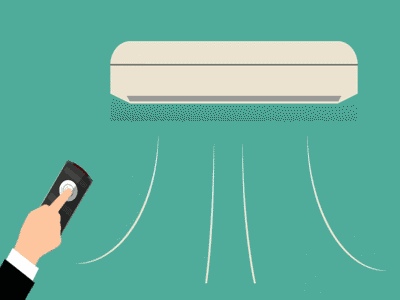Two copper lines connect the outdoor air conditioner or heat pump to the indoor evaporator coil in an air conditioning system. The larger insulated refrigerant line, referred to as the “suction pipe,” transports the cool gas from the evaporator to the compressor, where it is converted back to liquid.
If the air conditioner is to function correctly, the pipe between the condenser and the evaporator must be kept at a constant temperature. The smaller copper pipe, referred to as a “liquid line,” transports liquid refrigerant to the indoor evaporator coil. These refrigerant lines and their connections determine the efficiency of your air conditioning system.
When your AC system is new, the suction line is airtightly insulated. Over time, this insulation deteriorates, especially during the hot summer months, leaving gaps and tears. The insulator eventually dries out and seizes up, unable to perform its function.
This lack of refrigerant line insulation can adversely impact the overall functionality of a typical residential ac unit. First, the suction line starts to absorb heat, resulting in less cool gas returning to the compressor and your compressor running hotter. As a result, the cooling power of the air conditioner is reduced. It also results in condensation leaks into the building, which can cause costly structural damage.
Hence, keeping the refrigerant line insulation in place and maintaining it helps keep the AC system safe to operate at peak efficiency and prevent dripping and moisture damage.
Luckily, replacing or repairing the insulation is a simple and inexpensive task. This easy-to-follow home guide will show you how to insulate ac lines without much stress.
10 Easy Steps to Insulate AC Lines
Step 1. Identify the Correct AC Line to Insulate
The first step to insulating ac lines in determining which refrigerant lines require insulation. As earlier stated, two pipes connect the air conditioning unit to your home’s blower system. The pipes can be seen connecting the outdoor and indoor units.
The large cold copper pipe (the suction line) and the small warm tube (the liquid line). You should only insulate the larger (suction line) pipe. The smaller pipe does not require insulation because it is designed to disperse some of the heat as it travels inside.
Step 2. Measure the Length and Thickness of the Copper Pipe
The next step is to measure the diameter and length of the pipe to ensure that you purchase the proper size insulation that perfectly fits the pipe. Insulation is typically available in 1/2 inch, 3/4 inch, and 1-inch thicknesses. To determine the size of the copper, check the manufacturer’s recommendation attached to the AC unit.
Step 3. Purchase Insulation
Once You have the measurements, you can go to any home improvement store in your area and buy new AC pipe insulation. The different insulation materials include fiberglass, foam rubber, and polyethylene foam.
Polyethylene foam is regarded as the best material and is probably the most widely used. It is easy to install and inexpensive. Foam rubber insulators are also easy to install and can last a long time.
Other materials required to insulate ac lines include; foil tape or electrical tape, a utility knife, and scissors.
Step 4. Turn Off the AC
Once you’ve gathered all of the materials needed to insulate the ac lines, it’s time to put your new insulator in place. Begin your installation by turning off the air conditioner for a few minutes to allow the pipes to cool down. This could take 5 minutes.
Step 5: Remove the Old Insulation and Clean the Pipe
Remove the old insulation from the pipe with care. Because the insulator may be difficult to remove, cut it off with a utility knife. Be careful not to push the blade too hard to avoid cutting the copper pipe.
Also, clean off the dirt on the pipe using an appropriate solvent, such as denatured alcohol. Your insulation will not last as long if your pipes are clogged with dirt and grime.
After the pipe is clean and dry, wrap a few winds of insulation tape around the tubing where it exits the house, and wrap the service valve on the condenser end of the tubing. Ensure that the insulation tape is tightly wrapped around the service values and firmly pressed against the exterior wall.
Step 6: Cut New Insulation
Cut the new foam pipe insulation using scissors to fit the pipe using a utility knife. To account for temperature contraction and expansion, you may need to cut the foam insulation end at least an inch longer.
Step 7. Wrap the Foam Around The Pipe
The foam is usually split along the length of the insulation, and the edges are coated with a sticky adhesive. Slide the insulation roll over the pipe and push it into place to completely cover the pipe.
Step 8: Peel Off the Protective Tape
The insulator has strips that protect the glue on the slit pieces’ edges. Peel out the strips once the insulation is in place so that the sticky edges can adhere to one another. Press the seam together to ensure no overlap on the edges and align the insulator correctly.
Step 9. Wrap the Edges of The Foam With Tape
To seal the insulation, you’ll need a protective finish to seal the insulation, such as foil-faced tape or electrical tape. The tapes also aid in protecting the insulation from sun damage for the next few years. As a result, you can not use cheap paper tape. Also, do not pull the tape too tightly to avoid squeezing the insulator.
If you follow these steps on how to insulate ac lines correctly, you will have your insulation installed perfectly on the pipe, giving the suction line a better appearance. However, changing your insulation AC lines is an excellent way to keep your air conditioning unit running cold, so we recommend hiring a professional to insulate your AC lines for better results.
Hiring an AC Maintenance expert in Spokane WA
The best way to keep your AC working is to get a licensed and insured HVAC profession to service it every year. If you notice your energy bill skyrocketing or your ac leaking freon, it may be faulty ac pipes.
Are you still confused about how to insulate your ac lines in Spokane, WA? Hurliman Heating provides comprehensive ac maintenance services, including insulating ac lines in Spokane, WA. We replace your old insulation with the hugest quality materials. to keep your home comfortable all year round.






